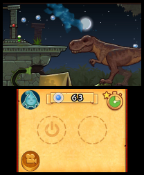Fluidity: Spin Cycle Review
|
|
See PixlBit's Review Policies

On 04/11/2013 at 12:00 PM by Nick DiMola If you're expecting more of the first, don't. |

If you’re really jonesing for more Fluidity, it’s worth a look; just don’t expect the same quality present in the first game.
While WiiWare never made quite the splash that competing services XBLA and PSN did, it still managed to offer a few gems. Fluidity was one such title, providing Metroid-inspired exploration along with physics-based puzzles starring an amorphous blob of water that could phase change between ice and steam. Spin Cycle follows that experience with a more linear adventure that’s broken out into a set of 60 levels. The shift away from the original design proves less successful, with a number of the levels falling flat in their implementation.

Like the original title, your character—now known as Eddy the Water Spirit— incrementally earns new abilities. At the start of the game, you can do very little with Eddy. Tilting the 3DS side to side to moves him and a button press allows for him to jump. There’s little question that the tilt controls are a bit unwieldy at first, but you eventually adapt and begin to move with much greater ease. Down the line, you’ll earn the ability to group Eddy back up into a tighter droplet of water for a limited time, or phase change to pass through an obstacle.
Given the technology of the Wii Remote, full 360° tilting was never a possibility; however, the 3DS allows players to explore this new dimension of control in a given subset of levels. While a technological impediment in the first title, its implementation here proves that the idea was better left on the cutting room floor, as it might be one of the worst ideas present in the experience.

As you can imagine, twisting your 3DS to and fro is awkward enough already, but when you are making a complete twist, it’s easy to tap an errant button and completely mess up your progress. Depending on what goals you’re driving towards, you may be forced to restart a level to hit some of the time-based goals.
The fact that the game has an unimpressive start only adds to disappointment. The first 10-15 levels are an absolute chore to work through. With only 60 levels in the whole game, seeing a quarter of them squandered on monotony is unfortunate and a frustrating way to kick things off. They’re also devoid of the more interesting phase change capabilities that open up the gameplay.

Unquestionably, the hardest pill to swallow is the movement to the level-based structure of Spin Cycle from the first game. Part of the appeal was navigating and exploring that sandbox world in a completely unconventional manner. Now that the experience has been shoehorned into segmented chunks, it plays out much more like a standard puzzle game.
Despite picking up quite a bit of personality with the new story and the introduction of Eddy as a character, Fluidity has lost the soul that made it unique the last time around. While I wasn’t necessarily having a bad time working my way through the game, it didn’t capture me the same way the first game did.

If the format change doesn’t bother you much, Spin Cycle offers quite a bit of content for you to sink your teeth into. Each of the 60 levels offers different completion benchmarks to fully clear it, which will get you going through each and every level multiple times to hit all of the objectives, if you’re the completionist type.
You’ll notice that this review is a little… late. If that isn’t indicative of my ambivalence towards Fluidity: Spin Cycle, I don’t know what is. It’s not a terrible game, just a thoroughly mediocre one. No matter how many times it manages to get its hooks into you, it always fails to keep you on the line. The truth is, eventually you stop coming back for the bait – I know I did.











Comments